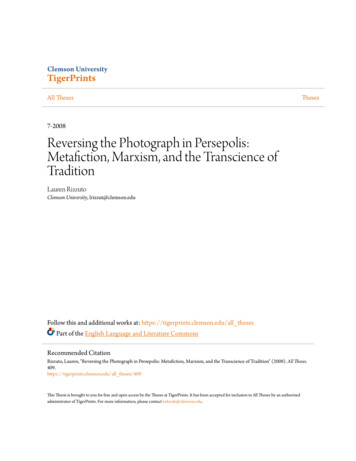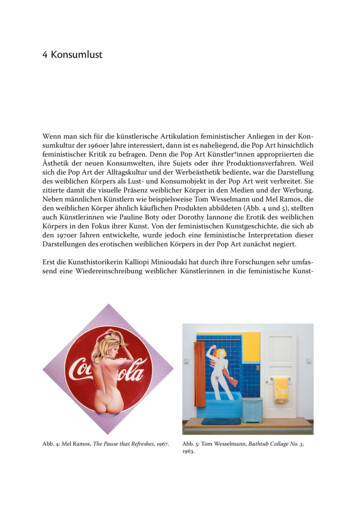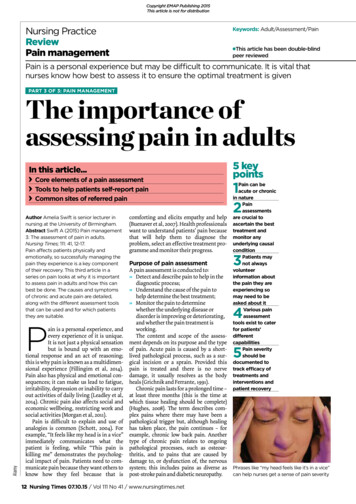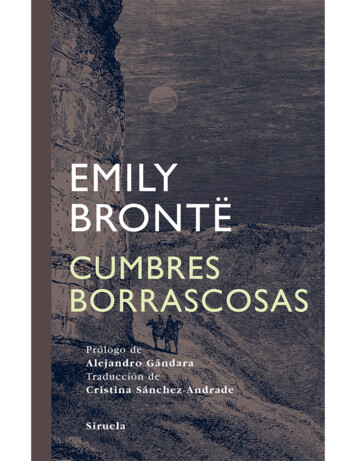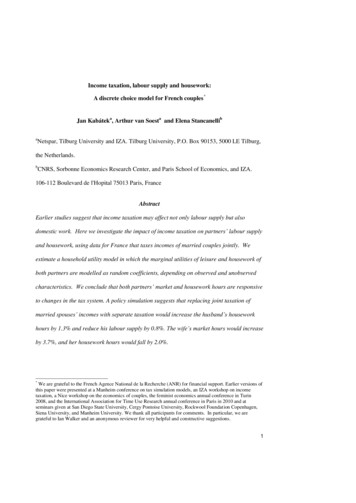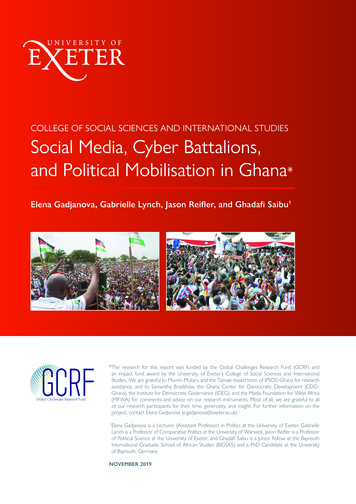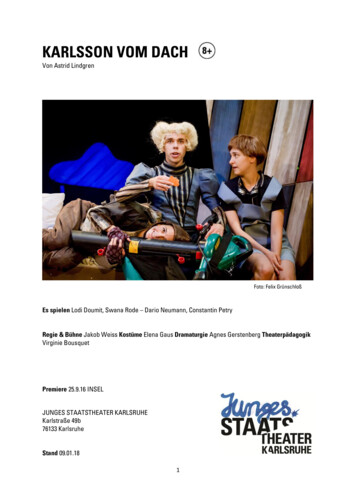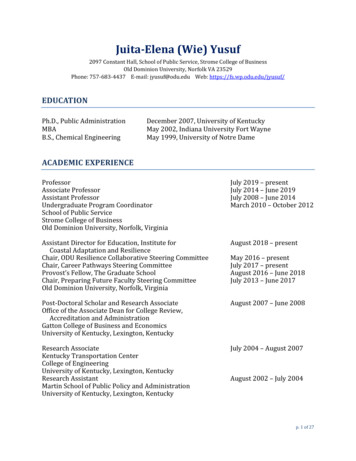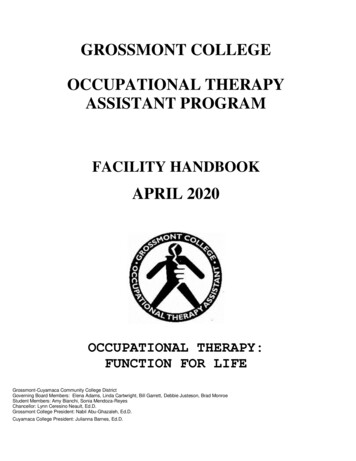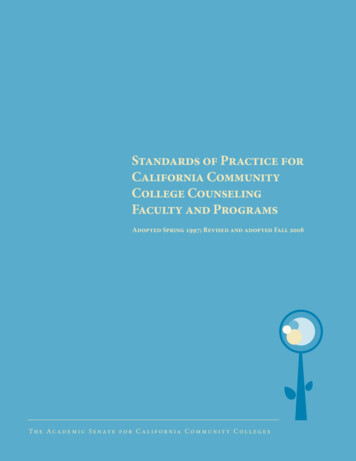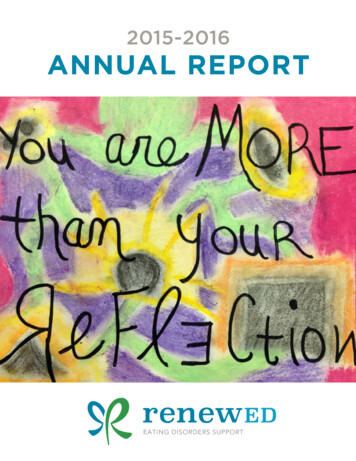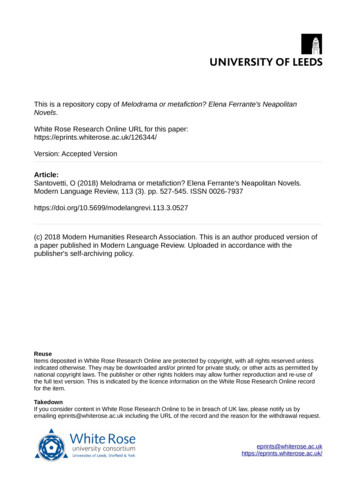
Transcription
This is a repository copy of Melodrama or metafiction? Elena Ferrante's NeapolitanNovels.White Rose Research Online URL for this on: Accepted VersionArticle:Santovetti, O (2018) Melodrama or metafiction? Elena Ferrante's Neapolitan Novels.Modern Language Review, 113 (3). pp. 527-545. ISSN 3.0527(c) 2018 Modern Humanities Research Association. This is an author produced version ofa paper published in Modern Language Review. Uploaded in accordance with thepublisher's self-archiving policy.ReuseItems deposited in White Rose Research Online are protected by copyright, with all rights reserved unlessindicated otherwise. They may be downloaded and/or printed for private study, or other acts as permitted bynational copyright laws. The publisher or other rights holders may allow further reproduction and re-use ofthe full text version. This is indicated by the licence information on the White Rose Research Online recordfor the item.TakedownIf you consider content in White Rose Research Online to be in breach of UK law, please notify us byemailing eprints@whiterose.ac.uk including the URL of the record and the reason for the withdrawal terose.ac.uk/
Melodrama or metafiction? Elena Ferrante's Neapolitan NovelsAbstractThe fusion of high and low art which characterises Ferrante's Neapolitan Novels is one of the reasonsfor her global success. This article goes beyond this formulation to explore the sources of Ferrante'snarrative: the 'low' sources are considered in the light of Peter Brooks' definition of the melodramaticmode; the 'high' component is identified in the self-reflexive, metafictional strategies of the antinoveltradition. Particular attention is given to the reflection on the act of writing (four metaphors arediscussed). The Neapolitan Novels are presented as self-reflexive texts: a 'postmodern' novel offormation of a writer who while narrating thinks about the writerly process and what it means to be awriter, particularly a woman writer today.Melodrama, according to Peter Brooks' famous formulation, is 'a mode of heightened dramatisationinextricably bound up with the modern novel's effort to signify'. 1 Originated in the popular tradition ofthe pantomime, developed in the theatre, melodrama found fertile ground in the literary genre of thenovel which was reaching its peak in the nineteenth century. In Brooks' exploration of the works ofBalzac and Henry James, the 'melodramatic imagination' combines the categories of 'novel' and'romance' (if we adopt the distinction of the Anglo-American tradition) by operating halfway and takingfrom both: its subject – the ordinariness of life – from the former and its strategies from the latter ('quest,escape, and fall-expulsion-redemption are in fact all structures that can be classed in the general category1Peter Brooks, The Melodramatic Imagination. Balzac, Henry James, Melodrama, and the Mode ofExcess (New Haven and London, Yale University Press, 1976), p.ix. For a more specific definitionsee pp.11-12: 'The connotations of the word [melodrama] are probably similar for us all. Theyinclude: the indulgence of strong emotionalism; moral polarization and schematization; extremestates of being, situations, actions; overt villainy, persecution of the good , final reward of virtueinflated and extravagant expressions, dark plottings, suspense, breathtaking peripety'.1
of romance (in Northrop Frye's term)').2 This brings Brooks to argue that melodrama is not confined topopular entertainment, but is in fact a pervasive presence in the novel even in its most compellingexperimentations (as he brilliantly demonstrates in the case of Henry James). His book was pioneering inchallenging the idea of a cultural hierarchy and made critics rethink how low and high cultural forms areintertwined. In this study I will argue that The Melodramatic Imagination (1976) can be used today as acritical platform to understand the extraordinary success of Elena Ferrante's Neapolitan Novels.Ferrante's works not only aptly fit Brooks' definition but can be seen as updating it with a postmoderntwist, by which the melodramatic mode acquires a distinctive metafictional layer.'Un grande melodramma'?Elena Ferrante had been a writer for almost twenty years (her debut novel L'amore molesto was in 1992)when in 2011 she published L'amica geniale, the first of four volumes which was to make her aninternational literary sensation both in terms of commercial success (translated into more than 50languages, 5.5 million copies sold worldwide 3) and of critical acclaim.4 The elements of continuity andnovelty between the Neapolitan Novels and Ferrante's earlier works were pointed out as early as 2012when the second volume of the series came out: continuity, notes Laura Benedetti, was mainly thematic(the city of Naples; the dichotomy between language and dialect; the focus on female relationships); the2Brooks, The Melodramatic Imagination, p.30.3Alexandra Alter, '“Ferrante Fever” continues to spread', The New York Times, 7 December nte-fever-continues-to-spread.html? r 0 [accessed 1January 2018].4Starting from James Wood's seminal review on The New Yorker, 'Women on the Verge', 21 January2013 n-on-the-verge [accessed 1 January2018], which sanctioned the international fame of Ferrante, the first of a long list of articles andreviews on American and English literary journals and media outlets dedicated to the NeapolitanNovels. This critical appraisal led to Ferrante being nominated by Foreign Policy in 2014 as one ofthe world's global leading thinkers and included in Time's 100 Most Influential People of the year for2016; her last volume of the Neapolitan quartet, Storia della bambina perduta was nominated for theStrega prize and in the UK shortlisted for the Man Booker International Prize as well as for the BestTranslated Book Award. On Ferrante's success in America see Laura Benedetti, 'Elena Ferrante inAmerica', Allegoria, 73 (2016), pp. 111-17, and Grace Russo Bullaro and Stephanie V. Love,'Introduction: Beyond the Margins: “Ferrante Fever” and Italian Female Writing', in The Works ofElena Ferrante. Reconfiguring the Margins, ed. by Grace Russo Bullaro and Stephanie V. Love(Basingstoke, Hampshire: Palgrave Macmillan, 2016), pp.1-12.2
element of novelty is primarily in the narrative pace and structure which now accommodate a large-scalefresco; L'amica geniale – says Benedetti – marks the passage 'dalla storia privata ad un affresco epocalein cui vengono tratteggiati non solo rapporti interpersonali ma anche i cambiamenti di un quartierenapoletano dal dopoguerra alla soglia degli anni Sessanta'. 5 The broader scope – and more complexstructure – was accompanied by the serialisation which distinguished her new work. With the secondvolume, Storia di un nuovo cognome (2012), reviewers openly remarked on the similarities betweenFerrante's novel and the feuilleton or nineteenth-century melodrama. Beatrice Manetti in her review onthe Indice dei libri del mese for December 2012 brought the attention to the repertoire of tricks ornarrative devices at work in Ferrante's novel, including 'il vecchio trucco da feuilleton' of the foundmanuscript: in this case the box of Lila's notebooks which at the beginning of Storia di un nuovocognome allows Elena the narrator to tell the story from the point of view of her friend (we might alsonote the many coup de théâtre, the cliffhanger ending with the sudden appearance of Nino, who launchesa defence of Elena in the heated discussion at her book launch in the finale of the volume). 6 Anotherreview on the same page of Indice refers to the 'trucco del feuilleton' as a broader category by which theauthor, Rossella Milone, means serialisation itself through which Ferrante's story captivates the attentionof the readers and secures their loyalty. 7 Serialization is a powerful device of contemporary cinema andtelevision, so much so that the Neapolitan Novels are said to be in debt also to the contemporary5Laura Benedetti, 'Il linguaggio dell'amicizia e della città: L'amica geniale di Elena Ferrante tracontinuità e cambiamento’, Quaderni d’Italianistica, 2, 2012, 171-87 (p.171).6Beatrice Manetti, 'Due di due', in L'indice dei libri del mese, n.12, December 2012, p.13: [Storia diun nuovo cognome] inizia in un giorno di primavera del 1966, quando Lila consegna ad Elena unascatola con otto quaderni. [.] Nel vecchio trucco da feuilleton, la cui funzione principale è appuntoquella di riprendere il filo del racconto, risuona allora una domanda allarmante [.]: a chi appartienequesta storia'.7Rossella Milone, 'Il trucco del feuilleton', L'indice dei libri del mese, n.12, December 2012, p.13:'Una storia che si allunga nel tempo cattura la curiosità del lettore e, soprattutto, lo fidelizza'.3
successor of the feuilleton, that is the TV series, the soap-opera, the graphic novel, and the filmmelodrama.8The Neapolitan Novels as 'un grande melodramma – o se si preferisce, un grande feuilleton', werethe subject of an entire essay by Raffaele Donnarumma. The Italian critic suggests that the melodramaticquality of Ferrante's work is the key to understand both her extraordinary success as well as the negativereaction that her novels received from a section of the Italian academia. 9 Tiziana de Rogatis reinforcesthis point in her introduction to the recent Allegoria volume dedicated to Ferrante (which features,among others, Donnarumma's essay). The introduction, with the telling title 'Chi ha paura di ElenaFerrante?' ['Who is afraid of Elena Ferrante?'] ponders why when the debate on Neapolitan Novels wasspreading internationally, with conferences and events organised in US and UK universities andscholarly volumes published abroad, Ferrante's works had been ignored, when not openly dismissed, inItalian universities (the Allegoria volume edited by de Rogatis in 2016 had the intention of addressingthis silence).10 A case in point was the polemic caused by the nomination for the 2015 Strega prize of thelast volume of the series, Storia della bambina perduta. Among the others, Renato Barilli, Emeritusprofessor of the University of Bologna, an eminent critic of the 'gruppo 63', wrote a hostile review in hisblog entitled 'Perché non si deve premiare la Ferrante' and pointed the finger to 'una scrittura che scorrevia priva di nerbo, di carattere, con una pletora di personaggi che tentano di rimediare col numero a una8Laura Buffoni, 'Elena Ferrante sono io', Internazionale, 30 November 2014: 'Nel caso di ElenaFerrante questi strumenti artigiani sono forgiati sulla tradizione “pop”: il feuilleton, il romanzod’appendice; e, naturalmente, sui suoi eredi a noi più vicini: il melodramma, il fotoromanzo, la soapopera, la serie tv'. i/2014/11/30/elena-ferrantesono-io [accessed 1 January 2018].9Raffaele Donnarumma, 'Il melodramma, l'anti-melodramma, la Storia: sull'Amica geniale di ElenaFerrante', Allegoria, 73, 2016, 138-147 (p.138): 'Inutile girarci attorno: L'amica geniale è un grandemelodramma – o se si preferisce, un grande feuilleton. Stanno in questo molte ragioni sia del suosuccesso di pubblico, sia dello sfavore con cui l'ha giudicato una parte dell'accademica soprattuttoitaliana'.10Tiziana de Rogatis, 'Chi ha paura di Elena Ferrante?', Allegoria, 73, 2016, 109-10.4
piattezza di eventi'.11 A similar argument had been already used by Paolo Di Paolo in Il corriere dellasera when in 2014 he puzzled over Ferrante's success abroad writing disparagingly of her 'trame oliate'and comparing them to a popular Italian soap, Un posto al sole.12 Interestingly, both reviews focused onthe feuilleton quality of Ferrante's work. This, of course, is not unusual: mixing with forms of popularentertainment has often been seen with suspicion, if not open disdain. The writer Elsa Morante foundherself at the centre of a similar controversy with La Storia, which was a literary sensation in Italy forty11Renato Barilli, 'Perché non si deve premiare la Ferrante', 26 February i-deve-premiare-la-ferrante/ [accessed 1 January 2018].A continuation of this polemic can be found in the recent article by Stefano Jossa, 'Perché non sideve studiare Ferrante all'università', Doppiozero, 20 May ve-studiare-la-ferrante-alluniversita [accessed 1January 2018]). Jossa does not comment on Ferrante's works but instead targets the scholars whostudy Ferrante at university. According to Jossa 'tanta critica accademica [ ] lavora oggi col cuscinosulla faccia del proprio oggetto. Mi scuso per la metafora, ma la situazione di gran parte della criticaè proprio questa: non conta il partner (l’oggetto del mio studio), ma la performance e il suo risultato(la mia ostentazione e il mio successo)'. The misogyny of this metaphor (a pillow over the face of awoman) is hard to miss. This is not an isolated reaction to Ferrante's success (see the debate stirredafter Claudio Gatti's article on Ferrante's identity on The New York Review of Books, 2 October 2016;in particular, the article by Jeanette Winterson, 'The malice and sexism behind the ‘unmasking’ ofElena Ferrante', The Guardian, 7 October /unmasking-elena-ferrante [accessed 1 January2018]). After all, the subtlety (but also the sincerity) with which Ferrante in the Neapolitan Novelshas made readers, female and male alike, experience the misogyny of our society is one of thereasons of her global appeal.12Paolo Di Paolo, 'Il caso Ferrante, il romanzo italiano secondo il New Yorker', Il corriere della sera,13 October 2014: ferrante-il-romanzo-italiano5
years ago. Published in 1974, Morante's novel sold more than 600,000 copies within months andprovoked a heated debate: its detractors saw La Storia as a 'romanzone', a nineteenth-century feuilletonout of time.13Donnarumma's article explains very effectively how the Neapolitan Novels exemplify Brooks'definition of melodrama as the aesthetic of excess: behind the banalities of quotidian existence, there is aworld of radical passions 'che non possono restare sepolte nell'interiorità ma debbono sempre sboccarenell'agire [ ]. Tutto è estroflesso' says Donnarumma.14 The representation, the drama, is never adequatefor carrying what is behind the passions that drive the characters. What Brooks noted for the novels ofBalzac and Henry James applies here: '[t]here is a constant effort to overcome the gap, which gives astraining, a distortion, a gesticulation of the vehicles of representation in order to deliver signification'. 15Indeed many of the features of the melodramatic mode can be found in the Neapolitan Novels.Donnarumma in particular dwells on the melodrama's capacity to account for the variety of the socialspectrum (all social classes are represented in the Neapolitan Novels) and for the characters' mobility(the story follows the successful and unsuccessful attempts at social climbing), and on the central roleplayed by recognition as a typical plot rIO/pagina.html [accessed 1 January 2018]13For example 'Contro il romanzone della Morante' written by Nanni Balestrini, Elisabetta Rasy,Letizia Paolozzi, Umberto Silva, Il manifesto, 18 July 1974, p 3, where the 'romanzone' is furtherdescribed as 'elegia della rassegnazione' and Morante disparagingly grouped among the'bamboleggianti nipotini di De Amicis' and Rossana Rossanda's article, 'Una storia d'altri tempi', Ilmanifesto, 7 August 1974, p.3. The debate surrounding La Storia is discussed in StefaniaLucamante, 'Le Lacrime: Morante and Her Critics', in Forging Shoah Memories in Italian WomenWriters, Jewish Identity, and the Holocaust (Basingstoke, Hampshire: Palgrave Macmillan, 2014),pp.153-63.14Donnarumma, p.139.15Brooks, p.199.6
Interestingly, Donnarumma's analysis ends up arguing that within the 'grande melodramma' ofFerrante, there is an opposite element, an anti-melodrama drive, that sabotages its own structure anddeprives it of resolution: no happy ending, no order is re-established and there is no final reward for the'virtuous' character.16 This tension, I believe, captures precisely the novelty of Ferrante's 'melodramatic'project: that is the capacity – or 'intelligenza creativa', to use the words of Tiziana de Rogatis – 'diimmettere i materiali dell'intrattenimento e della letteratura di consumo (quei “fondali bassi” di cui parlanella Frantumaglia) in una forma complessa, non residuale, ma al contrario sintonizzata con un bisognoantropologico dei nostri tempi' (here de Rogatis makes a poignant comparison to the analogous methodof Elsa Morante with La Storia).17 I will argue that this 'forma complessa', this combination of thenineteenth-century feuilleton with postmodern narrative strategies, this 'fusion of high and low art' as areviewer of The Economist aptly defined it, is one of the reasons for her great success among the AngloAmerican critics who have greeted her as 'a 21st-century Dickens':From a literary perspective, Ms Ferrante's approach is masterly. She uses the melodramatic tropesof soap opera to tell a cracking good story, all the while smuggling in piercing observations, like afile baked in a cake. Her work is reminiscent of a Neapolitan theatrical tradition calledsceneggiata, a kind of over-the-top musical melodrama about honour, betrayal and crime. Throughthis fusion of high and low art, Ms Ferrante emerges as a 21st-century Dickens, with readersclamouring for the next instalment at the shops.1816Donnarumma, p. 143: 'Elena Ferrante sceglie insomma il feuilleton, si appropria delle sue leggi conostinazione, e lo sabota, contestando l'illusione che esso ingenera: e cioè che nella vita tutto torni,tutto si ricompatti, tutto acquisti un senso'.17Tiziana de Rogatis, 'Metamorfosi del tempo. Il ciclo dell'Amica geniale', Allegoria, 73, 2016, 123-37(p.128)18'Ties that bind. A four-volume feminist novel from Naples has become an unlikely global hit', TheEconomist, 27 August 2015, 2488-four7
If the 'low' sources of Ferrante's art have been amply discussed and criticised (Ferrante herself frequentlyacknowledged her debt to the popular novel19), there is much to say about her ability and originality inusing a series of sophisticated and experimental narrative strategies belonging to the 'high' tradition ofthe novel. My aim in this article is to bring the attention to the metafictional, self-reflexive dimension ofthe Neapolitan Novels: an aspect that I see as pervading Ferrante's later works but which has not yetreceived enough critical attention (although in Italy scholars have highlighted crucially importantelements: Elisa Gambaro on the use of the unreliable narrator; and Caterina Falotico on themetanarrative structure20). Indeed, the Neapolitan series can be read as a novel of formation – and,postmodernly, de-formation – of a writer who while narrating ponders, explains, and exposes the veryact of writing, its mechanisms, and what it means to be a writer, particularly a woman writer today. 21 y-global-hit-ties-bind [accessed 1 January 2018]19Elena Ferrante, 'Il vapore erotico del corpo materno. Risposte alle domande di Marina Terragni eLuisa Muraro' in La frantumaglia (Rome, Edizioni e/o: 2012), pp.210-18 (p.217): 'Il fotoromanzo èstato uno dei miei primi piaceri di lettrice in erba. Temo che l'ossessione di ottenere un raccontotesissimo, anche quando narro una storia piccola, mi venga da lì. Non provo alcun piacere a scrivere,se non sento che la pagina è emozionate. Una volta avevo grandissime ambizioni letterarie e mivergognavo di questa spinta verso tecniche da romanzo popolare. Oggi mi fa piacere se qualcuno midice che ho scritto un racconto avvincente – per esempio – come quelli di Delly'.20See Elisa Gambaro, 'Il fascino del regresso. Note su L'amica geniale di Elena Ferrante', Enthymema,XI, 2014, pp.168-181; Caterina Falotico, 'Elena Ferrante: Il ciclo dell'Amica geniale traautobiografia, storia e metaletteratura', Forum Italicum, 49 (2015), 92-118. See also the reviews ofSimona Micali, 'La scrittura e la vita', L'Indice dei libri del mese, December 2014 and the abovementioned reviews by Manetti and Milone.21On the specific challenges faced by the woman writer see Mona Simpson, 'Elena Ferrante WritesFiction That Feels Autobiographical. But Who Is She?', The New Republic, 10 October 2014,8
this reason in this article I propose to analyse them as self-reflexive books with all the nuances ofmetafiction, metanarrative and autofiction.22 I will argue that this self-reflexivity contributes to themasterly fusion of high and low art that makes Ferrante's work so compelling.2. A story about writingLet us start by analysing the importance of writing in the symbiotic relationship between the two maincharacters: Elena and Lila. The reflection on writing appears most frequently in the framing chapters,that is those chapters at the beginning or at the end of the chronological blocks into which the story isdivided: Prologue, Childhood, Adolescence, Middle Time, Maturity, Old Age, Epilogue. It is notsurprising that it is in the chapters which link key passages of the story that we find the narrator pausingand turning her attention from the narrated events to the act of narration, from the story to the reasonsbehind writing her story. A good example is the following passage from the Prologue:Lila come al solito vuole esagerare, ho pensato.Stava dilatando a dismisura il concetto di traccia. Voleva non solo sparire lei, adesso, asessantasei anni, ma anche cancellare tutta la vita che si era lasciata alle spalle.Mi sono sentita molto arrabbiata.Vediamo chi la spunta questa volta, mi sono detta. Ho acceso il computer e ho cominciato ascrivere ogni dettaglio della nostra storia, tutto ciò che mi è rimasto in mente. (AG 18-19). ed [accessed 1 January 2018]; on female subjectivity and authorship see the excellent essay byKatrin Wehling-Giorgi, 'Elena Ferrante's Neapolitan Novels: Writing Liminality', Allegoria, 73,2016, 204-10.22See my introduction to Self-reflection in Italian Literature, The Italianist, 35, 3 (2015), 309–17.23From hereafter references to Elena Ferrante's Neapolitan Novels will be given in the text with thefollowing abbreviations: AG: L'amica geniale (Rome: Edizioni e/o, 2011); SNC: Storia del nuovo9
The narrator openly admits that she began to write after, or rather because of Lila's disappearance. Shewrites to bring Lila back – in more than one sense. Writing is a form of resistance against the obliterationof memory – by disappearing Lila also wanted to eliminate the life that she had left behind, their lifetogether ('cancellare tutta la vita che si era lasciata alle spalle'). But writing is also a way to defy herfriend, to challenge her one more time ('Vediamo chi la spunta questa volta'), which is also a form ofrevenge. Therefore, from the very beginning we are informed first about the symbiotic and competitivenature of this friendship, and, secondly, about the pivotal role played by writing.It is important to note, however, that this reflection on writing does not appear only in theframing chapters but permeates the whole dynamic between the two friends. We should not forget that itis the dream of becoming writers, inspired by the reading of Louisa May Alcott's Little Women, whichthey read for months ('a mente, l'una vicina all'altra, o a alta voce', AG 64), that cemented the friendshipand set the story in motion.24 The symbolic value of this dream, which Ferrante spells out in aninterview, is self-evident: it is 'una via di fuga', their way out from the neighbourhood and what it meant(the ignorance, the misery, the violence of their childhood).25 However it 'will prove a way out only forcognome (Rome: Edizioni e/o, 2012); SFR: Storia di chi fugge e di chi resta (Rome: Edizioni e/o,2013); SBP: Storia della bambina perduta (Rome: Edizioni e/o, 2014).24But see also AG 66: 'Pensammo che studiare molto ci avrebbe fatto scrivere libri e che i libri ciavrebbero rese ricche. La ricchezza era sempre un luccicore di monete d'oro chiuse dentroinnumerevoli casse ma per arrivarci bastava studiare e scrivere un libro. “Ne scriviamo uno insieme”disse Lila una volta e la cosa mi riempi di gioia. Forse l'idea prese piede quando lei scoprì chel'autrice di Piccole donne aveva fatto così tanti soldi che aveva dato un po' delle sue ricchezze allafamiglia'.25Elena Ferrante, 'Rimango nell'ombra perché contano i libri e mai i loro autori', di Paolo Mauri, LaRepubblica, 21 settembre 2012: 'In realtà ho usato Piccole donne perché volevo che con i soldidell'Orco delle favole le due bambine acquistassero un libro che indicasse loro una via di fuga'.10
Elena';26 the one who wins the scholarship to Pisa and later will start a career as a writer. 27 For Lila,forced to quit school by her father, writing will become problematic. 28 Not surprisingly, once grown up,writing is what divides the two friends. On the one side there is Elena the writer, on the other there isLila the non-writer: the one who, in spite of writing beautifully (a dazzling example, we are told, is theshort story La fata blu), deliberately gave up writing (symbolically, by giving Elena the metal box withher notebooks at the beginning of Volume 2). And yet the more Lila rejects writing the more shepervades the writing of Elena, she become the 'pungolo [ ] necessario': 'Voglio che lei ci sia, scrivo perquesto. Voglio che cancelli, che aggiunga, che collabori alla nostra storia rovesciandoci dentro, secondoil suo estro, le cose che sa, che ha detto o che ha pensato' (SFR 91). She is the goad that pushes Elena towrite, but which at the same time makes her always more dissatisfied, because she can never close thegap. But which gap?The gap – I suggest – is that between writing and life. While Elena wrote novels, Lila lived life –or 'created a novel' with real people, with real blood: 'il romanzo' says a Lila introjected inside herself,26Dayna Tortorici, 'Those Like Us: On Elena Ferrante', n 1, Issue 22, Spring e-like-us/ [accessed 1 January 2018]: 'In elementaryschool, Lenù is mesmerized by a “book” Lila writes called The Blue Fairy —a story written on a fewpages of graph paper bound with a dressmaker’s pin. They read Little Women together and make aplan to write a novel and get rich. Writing, they imagine, will be their way out of the neighbourhood.But writing will prove a way out only for Lenù'.27SNC 327: 'Io, Elena Greco, la figlia dell'usciere, a diciannove anni stavo per tirarmi fuori dal rione,stavo per lasciare Napoli. Da sola'.28On the different effect produced by Little Women on the individual life of the two friends seeGambaro, p.172: 'Piccole donne [ ] rappresenta per Elena il primo pungolo verso la faticosaconquista di un'autorialità femminile, ovvero della dimensione pubblica e sociale della scrittura; perLila segnerà l'inzio di un destino di frustrazioni dolenti e furibonde battaglie alla ricerca di un'identitàsempre sfuggente'.11
'l'ho fatto con le persone vere, col sangue vero, nella realtà' (SFR 285). This gives Lila an authenticitythat seems to be always eluding Elena. And indeed Elena's nightmare, particularly in the final volume,has to do with the eventuality of Lila finally writing her novel, the perfect novel capable of capturingthe authenticity of reality, a memorable novel:Di tanto in tanto prendevo uno dei miei volumi, leggevo qualche pagina, ne avvertivo la fragilità.Le mie incertezze di sempre si potenziarono. Dubitai sempre di più della qualità delle mie opere.Invece il testo ipotetico di Lila, in parallelo, assunse un valore imprevisto. Se prima ci avevopensato come a una materia grezza su cui avrei potuto lavorare insieme a lei, cavandone un buonlibro per la mia casa editrice, ora si mutò in un'opera compiuta e quindi in una possibile pietra diparagone. Mi sorpresi a domandarmi: se presto o tardi dai suoi file verrà fuori un racconto di granlunga migliore dei miei? Se io davvero non ho mai scritto un romanzo memorabile e lei, lei invece,lo sta scrivendo e riscrivendo da anni? Se il genio che Lila aveva espresso da bambina con la Fatablu, turbando la maestra Oliviero, adesso, in vecchiaia, sta manifestando tutta la sua potenza? Inquel caso il suo libro sarebbe diventato – anche solo per me – la prova del mio fallimento eleggendolo avrei capito come avrei dovuto scrivere ma non ero stata capace. (SBP 437)Somehow the hypothetical book of Lila, the non-writer, would mean the annihilation of Elena’s ownwork as a writer, it would be the proof of her failure. This passage touches a nodal point of the reflectionon writing to which I will return at the end. I will start now to unravel the origin of Elena'sdissatisfaction by comparing the reflections on writing found in the Neapolitan Novels with a series ofmetaphors about the act of writing which I see underlying the essays collected in the volume Lafrantumaglia.3. Metaphors of WritingBefore moving on to the metaphors, the concept of 'frantumaglia' needs to be clarified ('la frantumaglia'12
is both the title of a long letter-essay written in 2003 by Ferrante in response to the questions by twoeditors of Indice dei libri del mese, Giuliana Oliviero and Camilla Valletti, and the title of the volumewhich collects twenty years of letters, essays and interviews published in 2007, then
The Neapolitan Novels are presented as self-reflexive texts: a 'postmodern' novel of formation of a writer who while narrating thinks about the writerly process and what it means to be a writer, particularly a woman writer today. Melodrama, according to Peter Brooks' f
